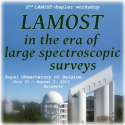Description
Stellar astronomy
Dr
Joanna Molenda-Zakowicz
(University of Wroclaw, Poland)
01/08/2017, 14:30
3.1 Science with the LAMOST
Invited Review
Since several years, the LAMOST instrument keeps providing us with detailed knowledge about various astrophysical objects. The extra-galactic part of the LAMOST survey allows us to get understanding about the large-scale structure of the Universe. The stellar part of the LAMOST survey provides information about stars in the Milky Way and the nearby galaxies, allowing us to study the structure...
Dr
Giovanni Catanzaro
(INAF - Catania)
01/08/2017, 15:10
3.1 Science with the LAMOST
Contributed talk
The Kepler four-years space mission and its K2 extension provide photometric time series with unprecedented accuracy. Given the relevance of these data, the introduction of large databases, as homogeneous as possible, collecting important astrophysical parameters such as temperature, gravity and metallicity became necessary. The LAMOST-Kepler project, based on LAMOST spectroscopy of Kepler...
Dr
Weikai Zong
(Department of Astronomy, Beijing Normal University)
01/08/2017, 15:30
3.1 Science with the LAMOST
Contributed talk
The LAMOST survey provides more than seven million spectra of stars which brings key information of basic parameters for those targets, building the largest stellar spectra library now and onward. Precise constraints on a great number of pulsating stars can be given by combining the LAMOST data with the photometric data from ground and space. In this talk, we first present the result of the...
Mr
Yuta Notsu
(Kyoto University)
01/08/2017, 16:20
3.1 Science with the LAMOST
Invited talk
Superflares are flares that release total energy $10$-$10^{4}$ times greater than that of the biggest solar flares with energy of $\sim10^{32}$ erg. Recent Kepler observations found more than 1000 superflares on a few hundred solar-type stars (e.g., Maehara+2012 Nature). Such superflare stars show quasi-periodic brightness variations with the periods from one to a few tens of days. Rotation...
Mengqi Jin
(department of astronomy of Beijing Normal University)
01/08/2017, 16:50
3.1 Science with the LAMOST
Contributed talk
About 1% of giant stars have been found to have high surface Li abundances, which is unexpected according to the standard stellar evolution models. Asteroseismology may help to understand the internal structures and evolutionary stages of the Li-rich giant stars, if stellar oscillations could be observed. Among 53 candidates of Li-rich giant stars in the LAMOST-Kepler fields, several stars are...
Mr
David S. Aguado
(Instituto de Astrofísica de Canarias)
01/08/2017, 17:10
3.1 Science with the LAMOST
Contributed talk
The most metal-poor stars in the Milky Way witnessed the early phases of the formation of the Galaxy, and have chemical compositions close to the pristine mixture from the Big Bang nucleosynthesis, polluted by one or very few supernovae. Here we present a program to search for and characterize new ultra metal-poor stars in the Galactic halo. These stars are extremely rare: despite significant...
Dr
Haining Li
(NAOC)
02/08/2017, 10:00
3.1 Science with the LAMOST
Invited talk
Surveys of very metal-poor (VMP) stars and follow-up spectroscopic studies for them in the past decade have provided with abundant information on the nature of first stars and early chemical evolution of the Milky Way. LAMOST will soon accomplish its first 5-year spectroscopic survey, and has already observed over 6 million Galactic stars. Such huge database will provide an unprecedented...
Ms
Li-Ching Huang
(Institute of Astronomy, National Central University, Taiwan)
02/08/2017, 10:30
3.1 Science with the LAMOST
Contributed talk
The Kepler space telescope has observed more than 2000 eclipsing binary (EB) systems during its primary mission between 2009 and 2013. According to the effective temperatures measured by Huber et al. (2014), we have selected about 131 systems with G-type primary stars characterized with Teff ~ 5000K-6000K for a statistical study. These classifications are compared to the spectral measurements...
Dr
Ádám Sódor
(Konkoly Observatory, Hungarian Academy of Sciences CSFK CSI)
02/08/2017, 10:50
3.1 Science with the LAMOST
Short talk
Short introduction of my scientific interests and how my work could benefit from LAMOST observations.
Prof.
Jun Ma
(National Astronomical Observatories, Chinese Academy of Sciences)
02/08/2017, 11:00
3.1 Science with the LAMOST
Short talk
Short introduction of my scientific interests and how my work could benefit from LAMOST observations.

